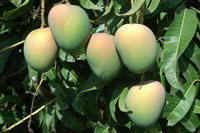 |
Alphonso:
It is one of the choicest varieties in India. It is
mainly grown in the Ratnagiri area of Maharashtra and to
a small extent in parts of South Gujarat and Karnataka.
Fruits are medium sized (250g), have attractive blush
towards the basal end. Pulp is firm, fibreless with
excellent orange colour. It has good sugar/acid blend.
Keeping quality of the fruit is good. It is susceptible
to spongy tissue. |
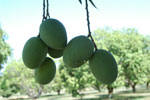 |
Banganapalli:
It is a
widely cultivated early season variety of South India.
It is the main commercial variety of Andhra Pradesh. The
fruits are large sized, weighing on an average of about
350 to 400g. The pulp is fibreless, firm with sweet
taste and is yellow in colour. Fruits have good keeping
quality. |
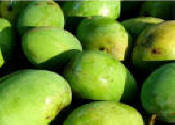 |
Bombay Green:
It is one of the earliest varieties of North
India. It is a biennial bearer. The fruits are
medium sized weighing around 250g. Fruits have
strong and pleasant flavour. Pulp is soft and
sweet. |
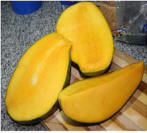 |
Chausa:
It is a late maturing variety of North India, which
matures during July or beginning of August. Fruits are
large weighing about 350 to 400 g. Fruits are bright
yellow in colour. Pulp soft and sweet. It is a biennial
bearer. |
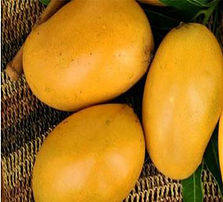 |
Dashehari:
One of the choicest varieties of North India. It is a
mid-season variety with biennial bearing tendency.
Fruits are medium sized, with pleasant flavour, tastes
sweet, pulp is firm, and fibreless. Stone is thin and
keeping quality is good. |
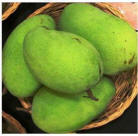 |
Himsagar:
It is one of the choicest varieties of West Bengal. It
is a regular bearer. It matures early. Fruits are medium
sized with excellent flavour. Taste is sweet. Flesh is
firm and fibreless. Keeping quality is good. |
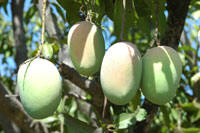 |
Kesar:
This is a famous variety of Saurashtra region of
Gujarat. It is an irregular bearing variety. Fruits are
medium sized. Flesh is sweet and fibreless. It has
excellent sugar-acid blend. Fruits ripen to attractive
apricot-yellow colour with a red blush. It has good
processing quality. |
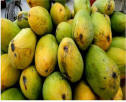 |
Kishanbhog:
It is indigenous to West Bengal. It is a mid-season
variety. Fruits are medium to large in size. Fruit
quality is good and flavour is pleasant and mildly
turpentine. Flesh is firm with few fibers. Keeping
quality is good.
|
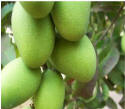 |
Langra:
It is one of the important commercial varieties of North
India. It is a biennial bearer. It is a mid-season
variety. Fruit quality is good. Flesh is firm with lemon
yellow colour, scarcely fibrous. It has a characteristic
turpentine flavour. Keeping quality is medium.
|
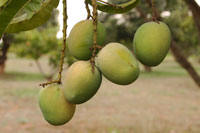 |
Goa Mankurd:
It is a mid-season variety. Fruits
are medium sized, skin yellow in colour. Flesh is firm,
and cadmium yellow in colour and fibreless. Keeping
quality is good.
|
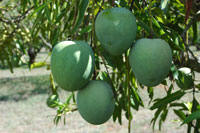 |
Mulgoa:
It is a late variety of South India and a poor yielder.
Fruits are large and round with good quality. Flesh is
firm, mustard yellow and fibreless. It has good flavour
and tastes sweet.
|
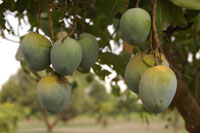 |
Neelum:
It is a heavy yielding late season variety of South
India with regular bearing habit. Fruits are medium
sized with good quality and flavour. Flesh is soft,
yellow and fibreless. Keeping quality is good.
|
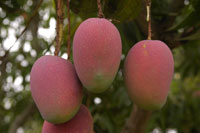 |
Suvarnarekha:
It is a variety indigenous to Andhra
Pradesh. It is a heavy and regular bearing variety. It
matures early. Fruit is medium, ripens to light cadmium
colour with red blush. Flesh is soft and primuline
yellow coloured and fibreless. Fruit quality is medium
to good. Keeping quality is good.
|
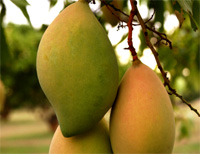 |
Totapuri:
This variety is grown widely in South India. It is
regular and heavy bearer. Fruits are medium to large
with prominent sinus. Fruit quality is medium. It has
typical flavour and tastes flat. Flesh is cadmium yellow
and fibreless.
|
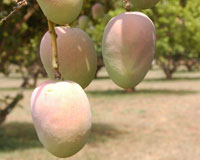 |
Fernandin:
It is a variety indigenous to Goa.
Fruits are medium sized and are sweet to taste with deep
yellow and firm pulp. Pulp is free from fiber. Fruits on
ripening get red blush in yellow background.
|
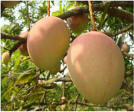 |
Vanraj:
It is a variety found and
grown in the state of Gujarat. Fruits are medium to big
sized weighing on an average about 300g. Pulp becomes
soft on ripening. Pulp is deep yellow in colour and
sweet to taste. Fruits on ripening get attractive red
colour.
|
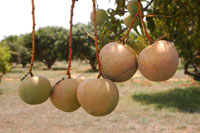 |
Rumani:
This variety produces round shaped fruits having
uniform yellow skin colour with red blush. It is
grown extensively in the state of Tamil Nadu. Fruits
are sweet to taste. Pulp is yellow in colour and
becomes soft on ripening
|
|
|
Zardalu:It
is indigenous to Bihar and matures towards the end of
June. It is a biennial bearer with medium to heavy
bearing. Flesh is firm to soft, capucine yellow and
sparingly fibrous. Fruit quality is good, flavour
pleasant. Keeping quality is medium.
|
|
|
Pairi:
It is native to coastal Maharashtra including Goa and is
a popular variety in Karnataka It matures early and is a
heavy as well as regular bearer. Fruits are medium sized
with good quality. It has good flavour with good sugar
acid blend. Flesh is soft, primuline yellow and
fibreless. Keeping quality is poor.
|
|
|
Rajapuri:
It is one of the commercial cultivars of Gujarat. It is
a heavy and regular bearer. Fruits are large sized. It
matures during early to mid-season. Flesh is firm,
pinnard yellow and fibreless. Keeping quality is medium.
|
|
|
Jamedar:
It is a famous variety of Gujarat. It is a heavy and
regular bearing variety. Fruits are of medium sized
having good quality. Flesh is firm, yellow in colour,
fibreless with pleasant flavour. Keeping quality is
good. |
|
|
Fazli:
It is indigenous to Bihar and West Bengal and is a late
variety (maturing in August). Fruits are large with firm
to soft flesh. Flavour is pleasant and pulp is sweet and
fibreless. Keeping quality is good. |
|
|
Gulabkhas:
It is a variety indigenous to Bihar. It is a regular and
heavy bearer. It is mid-season variety. Fruits are small
to medium sized. It has good rosy flavour and tastes
sweet. Fruits are amber-yellow in colour with reddish
blush towards the base and sides. Keeping quality is
good. |
|
|
|
The mango improvement work started in India, has
resulted in several selections and hybrids from various
regions in the country. These are given below
|
.jpg) |
Mallika:
This hybrid between Neelum and
Dashehari was released from IARI, New Delhi. It has a
strong tendency for regular bearing. The fruits on an
average weigh about 350-400g with deep yellow pulp, high
TSS, good flavor, uniform fruits and moderate keeping
quality (Singh et al., 1972).
|
.jpg) |
Amrapali:
It
is from the parentage Dashehari x Neelum. Plants are
dwarf and have regular bearing habit. Fruits weigh on an
average about 180-250 g and are borne in clusters.
Fruits are sweet to taste and have good keeping
quality.
|
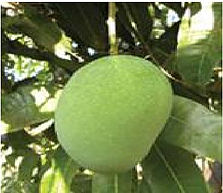 |
Ratna:
It is a hybrid from the cross Alphonso x Neelum released
by Fruit Research Station, Vengurla.
It is regular bearing, produces medium sized
fruits weighing on an average about 250 g.
Pulp is orange in colour and free from spongy
tissue and fibre.
|
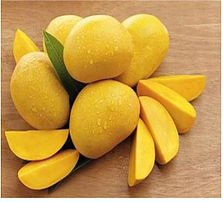 |
Sindhu:
It is a hybrid progeny derived by
back crossing Ratna x Alphonso released by Fruit
Research Station, Vengurla. Fruits are borne in
clusters. Fruits weigh on an average about 150-220g.
Pulp is deep yellow in colour and it has good sugar acid
blend. Fruits are almost seedless with very thin stone,
though fruits above 200 g have well developed seeds.
|
|
|
Au-Rumani :
It is a hybrid from the
combination Rumani x Mulgoa released by Fruit Research
Station, Kodur. It bears large fruits, good flavour,
heavy yielder, flesh moderately firm (Sachan et al.,
1988).
|
|
|
KMH 1:
It is a hybrid released from
Fruit Research Station, Kodur. It is from the parentage
Cherukurasam x Khader. Plants are semi dwarf, regular
bearing, fruits-fibreless has high brix and low acidity.
|
|
|
Manjeera:
This was released from Fruit Research Station,
Sangareddy. It is from the parentage Rumani x Neelum. It
produces round shaped fruits. It bears regularly and is
a prolific bearer, pulp is firm and fibreless.
|
|
|
Konkan Ruchi:
It is a hybrid from the cross Neelum x Alphonso. It is a
regular bearer. Fruits are large with thick skin, acidic
and preferred for pickling.
|
|
|
Konkan Raja:
It is a hybrid from the cross Banglora x Himayuddin.
Fruits are small to medium sized, less acidic and best
for salad purpose
|
|
|
Arunima:
It is from the parentage Amrapali x
Sensation, released by Indian Agricultural Research
Institute, New Delhi. The fruits are medium sized,
having attractive skin colour. The pulp is deep yellow
in colour and TSS is around 20°Brix. .
|
|
|
Pusa Surya :
It is a selection from the variety
Eldon released by Indian Agricultural Research
Institute, New Delhi. It bears medium sized fruits, has
red peel colour similar to Sensation.
|
|
|
Pusa Prathibha:
It is a hybrid between the
cross Dashehari X Amrapali developed by Indian
Agricultural Research Institute, New Delhi.
It is regular bearing variety with attractive
fruit shape, bright red peel and orange pulp. It has
oblong shaped, uniform sized fruits.
The plants are semi-vigorous. It has good sugar:
acid blend and uniform fruits.
|
|
|
Pusa Shresht:
It is a hybrid between the
cross Amrapalli X Sensation developed by Indian
Agricultural Research Institute, New Delhi.
Trees are semi vigorous, regular bearing with
elongated fruits and attractive red peel. Pulp is orange
in colour, fibreless and firm at ripening, moderate
sugar: acid blend with uniform fruit size (228g). It
contains good amount Beta -carotene and ascorbic acid.
|
|
|
Pusa Pitamber:
It is a hybrid between the
cross Amrapali X Lal Sundari developed by Indian
Agricultural Research Institute, New Delhi.
The plants are semi- vigorous, regular bearing
with attractive oblong fruits. Fruits turn uniform
yellow on ripening. It has good sugar : acid blend and
uniform size
fruits.
|
|
|
Pusa Lalima:
It is a hybrid between the
cross Dashehari X Sensation developed by Indian
Agricultural Research Institute, New Delhi. The plants
are semi- vigorous, regular bearer, attractive oblong
fruits with bright red peel on yellowish green
background with orange pulp and good
sugar: acid blend.
|
|
|
Ambika:
It is a hybrid between the
cross Amrapali
XJanaradhanPasand developed by
Central Institute for Subtropical Horticulture,
Lucknow. The fruits of this variety are medium in size
with slight sinus and beak and broadly pointed apex.
Peel is smooth and tough. Fruits are bright yellow in
colour with dark red blush. Pulp is firm with scanty
fibre. TSS
of this variety is 21o Brix. It is a late
maturing variety.
|
|
|
Arunika:
It is a hybrid between the
cross Amrapali
X Vanraj developed by
Central Institute for Subtropical Horticulture,
Lucknow. Fruits of this variety are attractive and with
red-blush. Fruit have high TSS (240 Brix) and
high carotenoids content.
Pulp is firm. Variety is regular bearer and
plants are dwarf in stature.
|
|
|
Pant Chandra: This
is a clonal selection of Dashehari from GovindBallabh
Pant University of Agriculture & Technology, Pantnagar.
Plants are tall with erect growth habit. Fruit colour at
maturity remains green.
It is a mid-season variety. Fruit weight is up to
150g. Fruit pulp is reddish yellow with total soluble
solids of 18% and
having pleasant aroma.
|
|
|
Pant Sinduri:
This is a clonal selection
of Dashehari from GovindBallabh Pant University of
Agriculture & Technology, Pantnagar. Trees are medium in
height with round top canopy. Fruit colour is yellow
with pink shoulder. Average fruit weight is up to 200g.
Fruit pulp is yellow with pleasant aroma. Total soluble
solids vary from 16-18% with average yield up to 150 kg
per tree. Fruit matures during last week of May to first
week of June.
|
|
|
PKM-1:
It is a hybrid released from
Horticultural Research Station, Periyakulam. It is of
the parentage, Chinnaswarnarekha x Neelum. It is regular
bearing, produces good quality fruits and bears in
clusters.
|
|
|
PKM-2:
It is a hybrid released from Horticultural Research
Station, Periyakulam. It is from the parentage Neelum x
Alphonso. It is regular bearing and produces good
quality fruits in clusters.
|
|
|
Al Fazli:
It is from the parentage Alphonso x
Fazli released by Fruit Research Station, Sabour. It is
superior to Fazli, does not have spongy tissue. Fruits
are sweet to taste.
|
|
|
Jawahar:
It is a hybrid between the
cross Gulabkhas X Mahmood Bahar developed by Bihar
Agriculture University, Sabour (Bihar). It is a mid-
season variety. Fruits mature from second week of June,
precocity and regularity in bearing. The fruits become
greenish yellow on ripening.
Its fruits are of medium size and average fruit
weight is 215g per fruit. Its pulp is light yellow in
colour, sweet in taste and pleasant flavoured and remain
firm even after ripening.
The TSS, acidity and pulp percentage are 22.5,
0.14 and 79.5 per cent respectively.
|
|
|
Menaka:
Menaka is selection from
Gulabkhas seedling. It is a regular bearing variety;
fruits are attractive with deep red basal portion. Pulp
is deep yellow, sweet and pleasant in flavour, less
fibrous and firm. Fruit shape is oblong-oblique. Average
fruit weight is 300g, late maturing variety and the TSS
of the fruit is 20 percent, acidity 0.14 per cent and
pulp content is 75 per cent.
|
|
|
Subhash:
It is a selection from the
seedlings of Zardalu. It is a mid-season variety, The
ripened fruits are bright yellow in colour as Zardalu
with the shape of Langra fruit, fruits are medium in
size with average weight of 220g. The TSS and acidity of
the fruits are 24 and 0.29 per cent respectively. The
pulp content is 76 per cent.
|
|
|
Sundar Langra:
It is from the cross
SardarPasand x Langra. It is regular bearing resembles
Langra in shape and size. Fruits are medium sized and
sweet to taste (Hoda and Ramkumar, 1993).
|
|
|
|